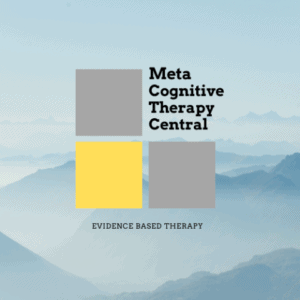
Before I was introduced to Metacognitive therapy (MCT), I used to practice Acceptance and Commitment Therapy (ACT), teaching my patients to distance themselves from negative thoughts. When I heard of MCT, I mistakingly thought that it was the same as ACT because both therapies aim to change people’s relationships with thoughts. However,
MCT and ACT are different types of treatments. MCT is founded on the S-REF model and ACT on RFT. MCT promotes minimal engagement with thoughts and instead changes metacognitive beliefs, whereas ACT relies on thought transformation techniques and clarification of values.
If you are struggling to choose between MCT and ACT, here is a description of the similarities and differences between the two types of therapies to help you out.
| Metacognitive Therapy (MCT) | Acceptance and Commitment Therapy (ACT) |
| What is mental illness: The mind regulates itself from negative emotions, but excessive thinking creates mental illness. | What is mental illness: Psychological suffering comes from listening to our thoughts and not following our values |
| Theory: Self-regulatory executive function (S-REF) | Theory: Relational frame theory (RFT) |
| Change technique: Detached mindfulness | Change technique: Cognitive defusion |
| Goal: Reducing worry and rumination | Goal: Clarifying values and planning goals |
| Approach to thoughts: Do-nothing approach to thoughts | Approach to thoughts: Thoughts are transformed (through funny voices and mindfulness) |
| Metacognition: Changing metacognitive beliefs about thoughts | Metacognition: No mention of metacognitive beliefs |
MCT focuses on reducing worry and rumination and changing false metacognitive beliefs about thoughts. ACT doesn’t mention metacognitive beliefs but instead focuses on living according to one’s values and pursuing one’s goals.
Both MCT and ACT focus less on directly reducing symptoms.
What is mental illness according to MCT vs. ACT?
MCT
According to Metacognitive Therapy, most psychological disorders develop from unhelpful coping styles like rumination and worry activated by motivated beliefs metacognitive beliefs.
Metacognitive beliefs are beliefs about the way we think. For example, most people with mental illness have metacognitive beliefs like “Worry is uncontrollable” or “I need to worry to feel better.”
Metacognitive beliefs encourage worrying about negative thoughts, which in turn makes us feel more stressed, sad, and anxious.
The unhelpful coping strategies are also called the Cognitive attentional syndrome, CAS, consisting mainly of rumination and worry, but also thought suppression, distraction, avoidance, and reassurance seeking.
What is mental illness according to MCT?
Metacognitive beliefs and CAS play an important role in whether we get mentally ill. This happens because metacognitive beliefs tell us to worry, ruminate, or suppress negative thoughts. In other words, Metacognitive beliefs activate the CAS, and extended CAS will inevitably make us feel anxious, depressed, and stressed.

ACT
Acceptance and Commitment therapy rests on an underlying theory of human language and cognition called relational frame theory (RFT). ACT was founded by Psychologist Steven C. Hayes.
The goal of ACT is not to eliminate difficult feelings but to be present with what life brings and to move toward valued behavior.
ACT promotes acceptance of difficult thoughts and feelings. Instead, one should embrace these. One of the core messages of ACT is to learn mindfulness skills to handle painful thoughts and feelings effectively so they have less impact on living and achieving important goals.
ACT also helps clarify what is truly meaningful through values. These skills will help to create a rich and meaningful life despite the pain that life inevitably brings.
Finally, ACT helps to set goals to take action toward creating that life.
Combined, this is called the model of psychological flexibility, and the goal of ACT is to create psychological flexibility.
What is mental illness according to ACT?
RFT has more than 30 years of empirical research behind it since it is a branch of radical behaviorism developed by one of the prominent persons in psychology, B. F. Skinner.
However, there is doubt whether ACT’s treatment success is as profoundly research-based as the theory of RFT itself. Unlike MCT, ACT does not have a specific formulation of what creates mental illness. The closest explanation is that when there is a gap between what we want and what we have, we feel distressed and suffer.
There have been claims against Hayes for only vaguely explaining the supportive research behind ACT. Most of the research linking ACT to symptom reduction is new and doesn’t have 30 years of academic research behind it, as Hayes claims.

Similarities between MCT and ACT
Some of these similarities might contribute to why MCT and ACT are confused with each other:
1. Less focus on illness
ACT work is based on the psychology of the normal, as is the foundation of MCT, which sees the mind as self-regulating. Therefore, both therapies encourage less focus on mental illness. Instead, focus should be directed away from problems (thoughts and feelings).
In MCT, the mind can heal itself from distressing thoughts, feelings, sensations, and memories. However, this self-regulation process gets blocked through excessive engagement with thoughts. Excessive engagement with thoughts typically happens through analysis, worry, rumination, and too much internal focus. So in order to recover from mental illness, one’s focus should be placed elsewhere.
Thoughts don’t matter, but your response to them does
Adrian Wells
Similarly, ACT accuses problem-solving, analysis, and evaluation of being toxic. According to Steven Hayes, the founder of ACT, once you start focusing on sadness, anxiety, or urges, problem-solving becomes unhelpful and pathological. ACT, therefore, encourages patients to focus on living by their values and planning important goals.
The more you try not to think of things, the more you actually think of them
Steven Hayes

2. Less focus on symptom reduction
In MCT, direct symptom reduction is not the focal point. Instead, the patient gradually experiences that he can choose to stand back from thoughts and move his attention around flexibly.
This change allows the mind to regulate distressing thoughts and feelings on its own.
ACT has a similar philosophy, although it is not grounded in a theoretical model of the mind. The point of ACT is that people are not broken and don’t need to be fixed.
According to ACT, rather than focusing on symptom reduction, it is better to support people to live by their values and achieve their goals.
3. Detachment from thoughts as a change technique
MCT uses a technique called detached mindfulness (DM) to stand back from thoughts and allow the mind to self-regulate.
DM is a contrast to handling thoughts through worry, rumination, analysis, and suppression. DM is a “do-nothing” strategy.
ACT uses a technique called cognitive defusion (defusion). The aim of defusion is also to stand back from thoughts instead of getting caught up in them.
Using defusion helps people become psychologically flexible and able to shift their attention from fear.
Detached mindfulness = To be aware of a thought and to do nothing about it (4)
Differences between MCT and ACT
The differences between MCT and ACT are more significant than their similarities, according to Wells, the founder of MCT. Some of the major differences are:
1. There is no direct attempt to reduce worry and rumination in ACT
MCT has, through extensive research (5), proved that worry and rumination cause mental illnesses like anxiety and depression. Therefore, MCT focuses explicitly on reducing worry and rumination.
ACT does not directly link worry and rumination to mental illness. However, in ACT, worry and rumination are called experimental avoidance strategies (strategies to avoid distressing thoughts and feelings), but these are still not directly addressed or reduced in therapy as they are in MCT.
2. Standing back from thoughts is different in MCT than ACT
There is also a difference in the therapeutic change techniques. For example, MCT helps to stand back from thoughts through detached mindfulness, which means minimal engagement with thoughts, whereas ACT relies on thought defusion, which is a thought transformation technique.
Detached mindfulness “a state of awareness of internal events, without responding to them with sustained evaluation, attempt to control or suppress them, or respond to them behaviorally…. by allowing the thought to occupy its own mental space without further action or interpretation“(4)
DM has two features: 1) mindfulness which means being aware of thoughts, feelings, memories, and beliefs; and 2) detachment which means not engaging with thoughts, feelings, memories, and beliefs, and that a person (the self) is separated from these inner events.
DM is used as a stand-alone technique. It is a “do nothing” to thoughts and feelings instead of transforming, worrying, analyzing, suppressing, or ruminating about them.
In ACT, the purpose of cognitive defusion is also to step back from thoughts.
Defusion is defined as:
“Instead of getting caught up in our thoughts or being pushed around by them, we let them come and go as if they were just cars driving past outside our house. We step back and watch our thinking instead of getting tangled up in it. We see our thoughts the way they are – nothing more or less than words and pictures.“ (6)

In theory, defusion and detached mindfulness look very similar. But, the way defusion is practiced in therapy requires more mental effort than “doing nothing” in detached mindfulness.
ACT utilizes many different strategies under the term defusion.
For example, one specific method encourages removing the literal content of thoughts by repeating the thoughts loudly, slowly, or in funny voices. Another defusion strategy is to describe an intrusive thought in colors or shapes. (6)
ACT also uses elements from mindfulness meditation in practicing defusion from thoughts. One of them includes imagining leaves floating down a stream and placing thoughts, feelings, and experiences on the leaves, and watching them float away.
These defusion strategies are not the same as detached mindfulness because they require more processing (doing something with the thoughts). This way, defusion becomes a thought control strategy that is not the same as a do-nothing strategy in detached mindfulness. (4)

3. There is no mention of metacognition in ACT
According to MCT, rumination and worry get activated by metacognitive beliefs. Metacognitive beliefs are beliefs about thoughts and feelings and shape whether we pay attention to distressing thoughts or the world outside.
Metacognitive beliefs make us use rumination and worry as coping strategies in response to stress and mood changes. For example, when intrusive thoughts come up, metacognitive beliefs are responsible for whether we ruminate about them or not.
Since metacognitive beliefs activate worry and rumination in the first place, there is a great focus on challenging and reducing them in MCT. In fact, changing metacognitive beliefs is the most important aspect of MCT.
Changed metacognitive beliefs help to prevent relapse into anxiety and depression.
In ACT, there is no mention or focus on changing metacognitive beliefs. The question is, therefore, how many people experience relapse after terminating therapy with ACT.
Similarities and differences summed up
Similarities between MCT and ACT
- Less focus on illness. Both approaches believe that, deep down, humans are healthy
- Less focus on directly reducing symptoms. More focus on living life without paying too much attention to distressing thoughts and feelings
- Stepping back from thoughts as a change technique in therapy
Differences between MCT and ACT
- MCT focuses directly on changing false metacognitive beliefs about thoughts. ACT doesn’t mention metacognitive beliefs
- Standing back from thoughts in MCT is a “do-nothing” technique. In ACT, thoughts are transformed by repeating them in funny voices, singing thoughts out loud, and placing them on leaves in the mind
- MCT reduces worry and rumination. ACT only focuses on thoughts, not rumination and worry processes.
References
- Photo by Marcos Paolo Prado
- Photo by Christina Wocinthechchat
- Photo by Pink Colibri
- Wells, A., (2009). Metacognitive therapy for anxiety and depression. Guilford press.
- Nolen-Hoeksema, S. The role of rumination in depressive disorders and mixed anxiety/depressive symptoms. Journal of Abnormal Psychology, 109(3), 504–511. https://doi.org/10.1037/0021-843X.109.3.504
- Harris, R. (2019). ACT made simple: an easy-to-read primer on acceptance and commitment therapy (2nd ed.). New Harbinger Publications.
- Photo by Vanesa Gaiconi
- Photo by Nordwood Themes
